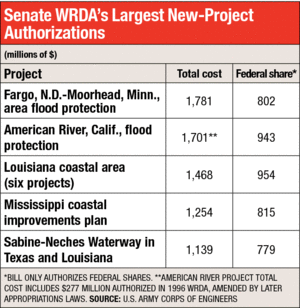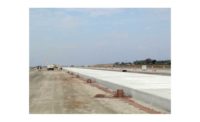

More than five years after the last Water Resources Development Act, or WRDA, became law, it is increasingly likely that Congress will pass a successor bill this year. The outlook brightened on May 15, when the Senate passed a new WRDA by a strong 83-14 vote. The bill authorizes Army Corps of Engineers' projects, changes Corps project-review policies and boosts funding. Interest groups now are zeroing in on the House, mapping out lobbying plans for that chamber's not-yet-introduced WRDA.
The key House player on WRDA, Transportation and Infrastructure Committee Chairman Bill Shuster (R-Pa.), says the bill is a top priority. He told reporters on May 16 he would like his panel to clear WRDA "sometime this summer."
With the congressional earmark ban in place, a key question is how Shuster's WRDA will deal with water-project authorizations. To adhere to the ban, the Senate bill's main authors, Barbara Boxer (D-Calif.) and David Vitter (R-La.), chose not to identify new projects in their measure. Instead, the bill authorizes any project that has a completed Army chief of engineers' report before enactment. So far, 27 such projects meet that criterion. Their federal funding shares total $4.5 billion over five years, the Congressional Budget Office estimates.
Shuster has voiced concerns about the Senate bill's approach to new projects, seeing it as ceding congressional authority to the executive branch. Amy Larson, National Waterways Conference president, says, "Our view is that the Congress is much better situated to make those kinds of water-resources investment decisions in an open and transparent way."
Whichever projects the final WRDA authorizes and by whatever definition, congressional appropriators will determine how much money the projects get per year. The current tight appropriations picture will make it tough for new WRDA projects to win those funds.
But Jim Walker, American Association of Port Authorities (AAPA) director of navigation policy and legislation, says having projects authorized in a WRDA is "an essential first step." When appropriators consider the new WRDA's projects, he predicts they "will compete well for those constrained federal dollars."
The Senate measure would create a five-year, $500-million Water Infrastructure Finance and Innovation Act program to back low-interest loans for Corps projects and non-Corps wastewater-treatment and drinking-water facilities. Adam Krantz, National Association of Clean Water Agencies managing director for government and public affairs, says, "It constitutes a new tool, but it will not solve the growing clean-water funding gap."
The Senate bill boosts funding for dredging projects by requiring Harbor Maintenance Trust Fund spending to rise gradually over five years, to $1.5 billion, roughly equalling the fund's income from export taxes. Walker says AAPA is pleased the Senate hiked trust-fund spending but would like to see the House bill provide "full access" to trust-fund income. He adds, "We'd like to get there a little earlier" than 2019.
The Senate bill also aims to speed Corps projects' environmental reviews by federal agencies. But the Associated General Contractors of America thinks those provisions don't go far enough, says Jimmy Christianson, director of government affairs for its federal and heavy-construction division. AGC would like the House to expand the use of exclusions of whole categories of projects from National Environmental Policy Act analyses.
But conservation groups think the Senate WRDA project-acceleration language greatly weakens environmental protection. Eileen Fretz, American Rivers director of flood policy, says environmentalists hope they can make improvements in those provisions before Congress clears the final WRDA.



Post a comment to this article
Report Abusive Comment